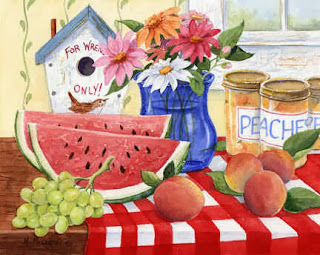MAR CALLEJÓN TORRES
Este blog ha sido creado para fines educativos.
domingo, 20 de abril de 2014
martes, 7 de enero de 2014
STILL LIFE ARTWORK
BILINGUAL ART CLASS:
>>>For more examples: (click en la foto)
>>> How to do it Watch this video:
A still life (plural still lifes) is a work of art depicting mostly inanimate subject matter, typically commonplace objects which may be either natural (food, flowers, dead animals, plants, rocks, or shells) or man-made (drinking glasses, books, vases, jewelry, coins, pipes, and so on). With origins in the Middle Ages and Ancient Graeco-Roman art, still-life painting emerged as a distinct genre and professional specialization in Western painting by the late 16th century, and has remained significant since then.
(Wikipedia Enciclopedia libre.)
(Wikipedia Enciclopedia libre.)
Enlaces para saber más:
- Wikipedia:
- Artyfactory:
- Listen to this music while creating your Still life artworks:
lunes, 6 de enero de 2014
PLANTS
There are hundreds of thousands of different plants in the world. How many kinds of plants can you think of? There are trees, bushes, vegetables, flowers, grasses, and many more. Even though there is such a variety of plants, all of them have several things in common.
Plants have roots. Roots are very important parts of plants in many ways. Roots absorb water and nutrients that plants need to grow. They also can store that food. Some plants like radishes, carrots, and turnips store their food in their roots. Roots also help to support plants. Have you seen the huge roots of some trees?
Plants have stems. Some plants use their stems for storage. Desert cacti store water and food in their stems. Stems move water and food from the plant's roots to its leaves and flowers. They also support leaves and flowers. You may think all stems are easy to see, like that of a tree. But some stems stay underground. The potato you eat is an underground stem!
Now watch this video and think of how many different things you would like to know about plants.
Plants have roots. Roots are very important parts of plants in many ways. Roots absorb water and nutrients that plants need to grow. They also can store that food. Some plants like radishes, carrots, and turnips store their food in their roots. Roots also help to support plants. Have you seen the huge roots of some trees?
Plants have stems. Some plants use their stems for storage. Desert cacti store water and food in their stems. Stems move water and food from the plant's roots to its leaves and flowers. They also support leaves and flowers. You may think all stems are easy to see, like that of a tree. But some stems stay underground. The potato you eat is an underground stem!
Now watch this video and think of how many different things you would like to know about plants.
viernes, 3 de enero de 2014
Brahms
Brahms
(1833-1897)
Johannes Brahms fue un excelente pianista y compositor alemán de música clásica del Romanticismo.
Entre sus obras orquestales se encuentran distintas sinfonías y oberturas.
Sin embargo las piezas más populares del compositor han sido las Danzas Húngaras.
Quizás la más conocida es la número 5.
(1833-1897)
Johannes Brahms fue un excelente pianista y compositor alemán de música clásica del Romanticismo.
Entre sus obras orquestales se encuentran distintas sinfonías y oberturas.
Sin embargo las piezas más populares del compositor han sido las Danzas Húngaras.
Quizás la más conocida es la número 5.
sábado, 28 de diciembre de 2013
Johann Sebastian Bach 2
Johann Sebastian Bach (Eisenach, Turingia, 21 de marzojul./ 31 de marzo de 1685greg., – Leipzig, 28 de julio de 1750) fue un compositor, organista, clavecinista, violinista, violista, maestro de capilla y cantor alemán de música del Barroco, el miembro más importante de una de las familias de músicos más destacadas de la historia, con más de 35 compositores famosos y muchos intérpretes destacados.
Su reputación como organista y clavecinista era legendaria, con fama en toda Europa por su gran técnica y capacidad de improvisar música al teclado.1 Aparte del órgano y del clavecín, también tocaba el violín y la viola de gamba.
Su fecunda obra es considerada como la cumbre de la música barroca; destaca en ella su profundidad intelectual, su perfección técnica y su belleza artística, además de la síntesis de los diversos estilos internacionales de su época y del pasado y su incomparable extensión. Bach es considerado el último gran maestro del arte del contrapunto.
Enlaces para saber más:
>>> Pinchar aquí para escuchar: Coral Jesús sigue siendo mi alegría, de la Cantata BWV 147 de Johann Sebastian Bach
Johann Sebastian Bach 1
Johann Sebastian Bach (Eisenach, Turingia, 21 de marzojul./ 31 de marzo de 1685greg., – Leipzig, 28 de julio de 1750) fue un compositor, organista, clavecinista, violinista, violista, maestro de capilla y cantor alemán de música del Barroco, el miembro más importante de una de las familias de músicos más destacadas de la historia, con más de 35 compositores famosos y muchos intérpretes destacados.
Su reputación como organista y clavecinista era legendaria, con fama en toda Europa por su gran técnica y capacidad de improvisar música al teclado.1 Aparte del órgano y del clavecín, también tocaba el violín y la viola de gamba.
Su fecunda obra es considerada como la cumbre de la música barroca; destaca en ella su profundidad intelectual, su perfección técnica y su belleza artística, además de la síntesis de los diversos estilos internacionales de su época y del pasado y su incomparable extensión. Bach es considerado el último gran maestro del arte del contrapunto.
Enlaces para saber más:
Johann Sebastian Bach, coral Jesús sigue siendo mi alegría, de la Cantata BWV 147
lunes, 23 de diciembre de 2013
Suscribirse a:
Comentarios (Atom)



